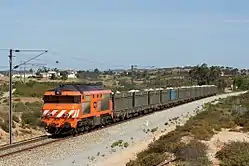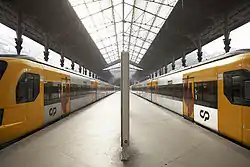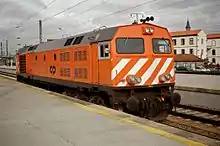Comboios de Portugal
CP — Comboios de Portugal, EPE (CP; English: Trains of Portugal) is a state-owned company which operates passenger trains in Portugal. Before June 2009, CP stood for Caminhos de Ferro Portugueses (English: Portuguese Railways) although the company has been using its current designation as a brand name since 2004.
 | |
| Type | Incorporation |
|---|---|
| Industry | Rail transport |
| Founded | 1856 |
| Headquarters | , |
Key people | Nuno Pinho da Cruz Leite de Freitas, Pedro Miguel Sousa Pereira Guedes Moreira, Ana Maria dos Santos Malhó, Maria Isabel de Magalhães Ribeiro, Pedro Manuel Franco Ribeiro |
| Products | Rail Transport (Passenger) |
| Revenue | |
| Owner | Government of Portugal (100%) |
Number of employees | 2,658 (2018)[1] |
| Website | www.cp.pt |
 Map showing the railway lines in Portugal operated by CP in 2007. Some closures have been held since then. | |
 A CP freight train in 2009 | |
| Technical | |
|---|---|
| Track gauge | 1,668 mm (5 ft 5 21⁄32 in) Iberian gauge and 1,000 mm (3 ft 3 3⁄8 in) metre gauge |




In 2019, CP transported 145 million passengers, 19 million more than in 2018.[2][3]
History
On 28 October 1856, the first railway line was inaugurated in Portugal, between Lisbon and Carregado: the Companhia dos Caminhos de Ferro Portugueses was born. The network was gradually expanded both south of the Tagus and to the north of the country, as well as in the metropolitan areas of Lisbon and Porto and to Spain. During the second half of the 20th century, much of CP's rolling stock was built in Portugal by Sorefame - notably carriages with stainless steel bodywork.
Gradually, electrification was put in place for a little less than half the network. In 1975, the company was nationalised, and its name was shortened to CP, A plan to finally connect all the district capitals by a fully electrified double line was to be implemented from 2010. Part of this plan is based on the Swiss Rail 2000 model.[4]
Manuel Antunes Frasquilho served as Chairman of the Board of directors between 1996 and 1997.[5]
The Vouga line is now the only narrow gauge line left in operation.
Infrastructure
The infrastructure of the Portuguese network is managed by Infraestruturas de Portugal, usually abbreviated to IP
Portuguese railway network extent:
- Broad gauge (1,668 mm (5 ft 5 21⁄32 in)): 2,603 km (1,617 mi), 1,351 km (839 mi) electrified at 25 kV 50 Hz AC and 25 km (16 mi) at 1.5 kV DC.
- Narrow gauge (metre gauge) 1,000 mm (3 ft 3 3⁄8 in): 188 km (117 mi) not electrified.
- The maximum extent of 3,592 km (2,232 mi) was reached in 1949, but in the late 1980s and early 1990s some lines were shortened and some totally closed.
Organisation
CP is split into four divisions:
Services
CP offers the following types of trains:
- International (IN) is the service that connects Portugal with Spain and France. These are the Sud-Express (Lisbon-Hendaye), Lusitânia (Lisbon-Madrid) and Celta (Porto - Vigo). Both Sud Express and Lusitânia are night trains that run under Renfe's Trenhotel (Hotel Train) brand.
- Alfa Pendular (AP) is the fastest service, whose speeds can reach 220 km/h. This service runs from Lisbon to either Porto, Braga or Guimarães (passing through Coimbra, Aveiro and Porto) or between Porto and Faro.
- Intercidades (IC) is a fast long-distance service whose speeds can reach 200 km/h. All IC services (apart from the Beja Shuttle) run from Lisbon to either Porto, Braga, Guimarães, Guarda, Covilhã or Évora (with connection at Casa Branca to Beja), serving the majority of the Portuguese regions. Service to southern Portugal runs to cities including Tunes, Faro, and Albufeira.[6]
- Inter-Regional (IR) is a medium distance service which stops only at the main stations. Runs mainly on the routes Porto-Viana do Castelo-Valença (Minho Line), Porto-Régua-Pocinho (Douro Line), Lisbon-Caldas da Rainha-Leiria-Coimbra (West Line) and Lisbon-Tomar (North Line). Services are operated by the same trains as Regional service.
- Regional (R) is CP's local service, stopping at all stations, out of the Lisbon and Porto suburban areas.
- Urbano (U) is the CP's urban service, in the regions of Lisbon and Porto and in the Coimbra-Figueira da Foz Line.
The network
CP's flagship service, introduced in 1999, is the Alfa Pendular which operates between Braga - Porto - Lisbon - Faro, at a top speed of 220 km/h (138 mph) with FIAT/Siemens tilting trains. As of 2006, CP's network reaches most of the country.[7]
CP inaugurated new trains in suburban service in the 1990s.
Lines/Routes
Iberian gauge
- Linha do Minho
- Ramal de Braga
- Linha de Guimarães
- Linha de Leixões (freight-only)
- Linha do Douro
- Linha do Norte
- Linha da Beira Alta
- Ramal de Alfarelos
- Linha do Oeste
- Ramal do Louriçal (freight-only)
- Ramal de Tomar
- Linha da Beira Baixa
- Linha do Leste
- Linha de Vendas Novas (freight-only)
- Linha da Matinha (freight-only)
- Linha de Cintura
- Linha de Sintra
- Linha de Cascais
- Linha do Alentejo (closed between Beja and Ourique; freight-only from Ourique to Funcheira)
- Linha de Évora (only opened between Casa Branca and Évora)
- Ramal Neves Corvo (freight-only)
- Linha do Sul
- Linha de Sines (freight-only)
- Linha do Algarve
- Linha do Leste (Passenger service revived on 29 Aug 2017: one "Regional" train daily in each direction between Entroncamento and Badajoz, running time three hours[8]
Metre gauge
- Linha do Vale do Vouga (partially closed; last 1000 mm gauge line)
Iberian gauge
- Ramal da Figueira da Foz (closed in 2009)
- Ramal da Lousã (closed in 2010 to allow the construction of the Metro Mondego; construction stopped due to lack of money)
- Linha de Évora (closed between Estremoz and Vila Viçosa in 1990 and between Évora and Estremoz in 2009)
- Ramal do Montijo (closed in 1989)
- Ramal de Portalegre (closed in 1990)
- Ramal de Mora (closed in 1990)
- Ramal de Montemor (closed in 1989)
- Ramal de Moura (closed in 1990)
- Ramal do Estádio Nacional (closed in 1979)
- Linha do Minho (closed between Valença and Monção in 1990)
- Linha da Beira Baixa (closed between Covilhã and Guarda in 2009, reopening scheduled for 2019)
- Linha do Douro (closed between Pocinho and Barca d'Alva in 1988)
- Ramal de Cáceres (closed in 2012)
Metre gauge
- Póvoa line (transformed into Porto Metro between Porto and Póvoa de Varzim between 2002 and 2006, closed between Póvoa de Varzim and Famalicão in 1995)
- Guimarães line (transformed into Porto Metro between Senhora da Hora and ISMAI in 2005, closed between ISMAI and Trofa in 2001, converted to Iberian gauge between Trofa and Guimarães in 2004 and closed between Guimarães and Fafe in 1986)
- Corgo line (closed between Vila Real and Chaves in 1990, remaining section closed in 2009)
- Dão line (closed in 1989)
- Sabor line (closed in 1988)
- Tâmega line (closed between Amarante and Arco de Baúlhe in 1990, remaining section closed in 2009. there are efforts to partially reopen the line)
- Tua line (closed between Mirandela and Bragança in 1992 and between Tua and Cachão in 2008, Metro de Mirandela reopened Mirandela–Carvalhais section in 1995 and explored the Cachão–Mirandela–Carvalhais section until 2019)
- Viseu branch (closed in 1990)
Future lines
- Lisbon–Porto high-speed rail line
- Évora–Elvas railway
Passenger rolling stock
Comboios de Portugal utilises the following rolling stock and commercial products:
 CP's 5600 Series (19 units) are responsible for most Intercity services. Four sold and five leased to Medway for freight use. One is here seen on the Linha do Sul, near Alcácer do Sal.
CP's 5600 Series (19 units) are responsible for most Intercity services. Four sold and five leased to Medway for freight use. One is here seen on the Linha do Sul, near Alcácer do Sal. CP's 4000 Series work all Alfa Pendular services. Here on is seen at Entroncamento on the Linha do Norte.
CP's 4000 Series work all Alfa Pendular services. Here on is seen at Entroncamento on the Linha do Norte. CP's 2240 Series are responsible for Urban (Lisbon's Sado Line and the Coimbra to Figueira da Foz urban service), Regional and Inter-Regional services. Unit 2295 is here seen on the Linha do Norte, near Entroncamento.
CP's 2240 Series are responsible for Urban (Lisbon's Sado Line and the Coimbra to Figueira da Foz urban service), Regional and Inter-Regional services. Unit 2295 is here seen on the Linha do Norte, near Entroncamento. Most of Lisbon's suburban trains (except the Cascais Line services), are in the hands of CP's 2300/2400 Series. Two are here seen on the Linha do Norte, near Santa Iria de Azoia.
Most of Lisbon's suburban trains (except the Cascais Line services), are in the hands of CP's 2300/2400 Series. Two are here seen on the Linha do Norte, near Santa Iria de Azoia. All Linha de Cascais urban trains are in the hands of CP's 3150/3250 Series.Two are here seen near Cruz Quebrada.
All Linha de Cascais urban trains are in the hands of CP's 3150/3250 Series.Two are here seen near Cruz Quebrada. CP's 3400 are responsible for all Porto urban services. One is here seen at São Bento station.
CP's 3400 are responsible for all Porto urban services. One is here seen at São Bento station. CP's 0450 Series are responsible for some Regional and Inter-Regional services. They are also in charge of the Intercity shuttle service between Casa Branca and Beja. One is here seen at Caldas da Rainha.
CP's 0450 Series are responsible for some Regional and Inter-Regional services. They are also in charge of the Intercity shuttle service between Casa Branca and Beja. One is here seen at Caldas da Rainha. CP's 1900/1930 Series were responsible for passenger (1930 only) and freight (both) services. Several sold to Medway and Ferrocentral (Argentina). All of CP uinits are withdrawn from service.
CP's 1900/1930 Series were responsible for passenger (1930 only) and freight (both) services. Several sold to Medway and Ferrocentral (Argentina). All of CP uinits are withdrawn from service. CP's 1960 Series were the most powerful locos in Portugal. They hauled both passenger (until the Beira Alta Line was electrified) and freight trains. Some sold to Medway. All of CP uinits are withdrawn from service. One is here seen at Porto Campanhã.
CP's 1960 Series were the most powerful locos in Portugal. They hauled both passenger (until the Beira Alta Line was electrified) and freight trains. Some sold to Medway. All of CP uinits are withdrawn from service. One is here seen at Porto Campanhã. CP's 0350 Series were once mainly used for Regional on unelectrified rural lines. As of 2021 only 3 remain in service. One is here seen at Guarda.
CP's 0350 Series were once mainly used for Regional on unelectrified rural lines. As of 2021 only 3 remain in service. One is here seen at Guarda. CP's 4700 Series were the backbone of their freight business. All 25 units were sold to Medway.
CP's 4700 Series were the backbone of their freight business. All 25 units were sold to Medway.
Major stations
Lisbon
- Cais do Sodré - for local trains from Lisbon to Cascais. Portugal's busiest interchange station (train/ferry/subway/tram/bus)
- Oriente - for trains to the north and to the Algarve
- Rossio - for local trains to Sintra
- Santa Apolónia - for trains to the north and to Spain
Porto
- Campanhã - Porto's main station, including use by Alfa Pendular high speed trains
- São Bento - city centre terminus, for local services, northbound and Douro line trains
Other
See also
References
- Comboios de Portugal (2018). "Relatório & Contas Consolidado" (PDF) (in Portuguese).
- https://www.cp.pt/institucional/pt/empresa
- "Passageiros e receitas da CP aumentam em 2019". Sol. 2020-03-08. Retrieved 2020-03-09.
- Stohler, Werner. "Modernização do sistema da exploração ferroviária da Região de Coimbra" (PDF) (in Portuguese). Archived from the original (PDF) on 11 August 2011. Retrieved 7 November 2010.
- CEEP Portugal - A Regulação dos Preços Como Instrumento de Regulação Pública dos Serviços de Interesse Geral
- See the timetable at www.cp.pt
- "CP route map" (PDF). Archived from the original (PDF) on 20 May 2011.
- "Archived copy". Archived from the original on 2017-08-31. Retrieved 2017-08-31.CS1 maint: archived copy as title (link)